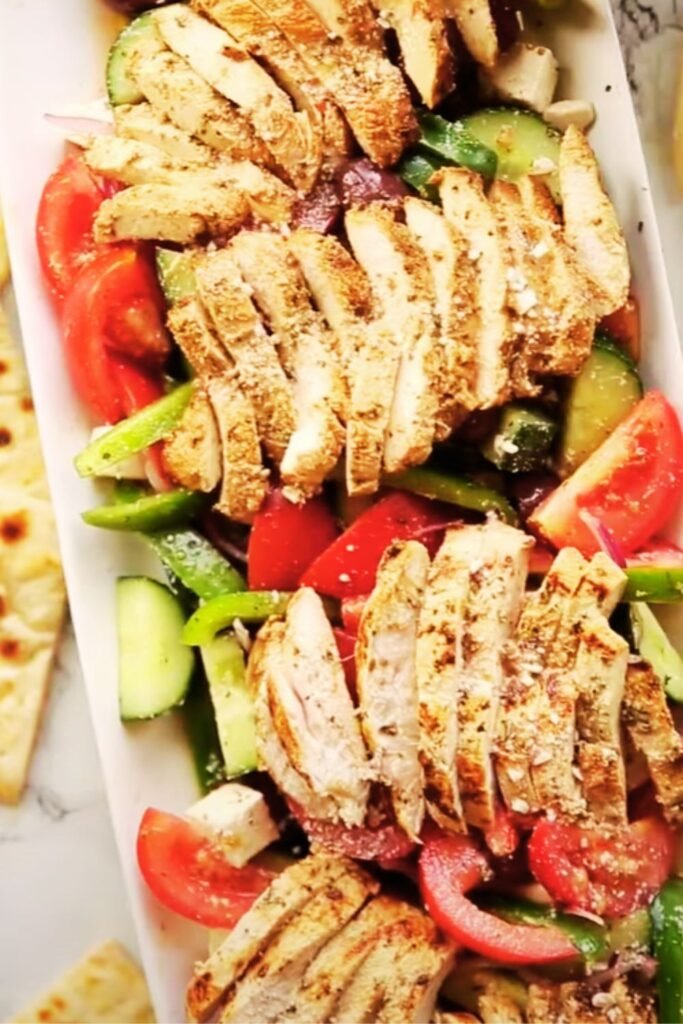When I first tasted authentic Mediterranean flavors during my travels through Greece, I knew I had to recreate that magical combination of fresh herbs, creamy textures, and vibrant vegetables in my own kitchen. This Mediterranean Chicken Salad with Creamy Tzatziki has become my go-to recipe when I want to transport myself back to those sun-drenched tavernas overlooking the Aegean Sea.
The beauty of this dish lies in its perfect balance of protein, healthy fats, and fresh vegetables, all brought together with a luscious homemade tzatziki that rivals any Greek restaurant. What makes this salad truly special is how it combines the heartiness of seasoned chicken with the refreshing crunch of cucumbers, the briny pop of olives, and the creamy richness of authentic Greek yogurt-based tzatziki.
The Mediterranean Diet Connection
Before diving into the recipe, let me share why this salad aligns perfectly with the Mediterranean diet principles that have captured the attention of nutritionists worldwide. The Mediterranean diet emphasizes:
Olive Oil: The primary source of dietary fat, rich in monounsaturated fats and antioxidants Fresh Vegetables: Abundant in vitamins, minerals, and fiber Lean Proteins: Like chicken, providing essential amino acids Herbs and Spices: Natural flavor enhancers with anti-inflammatory properties Yogurt: Probiotic-rich dairy that supports digestive health
This salad incorporates all these elements, making it not just delicious but also incredibly nutritious.
Ingredient Breakdown and Selection
For the Chicken
- 2 pounds boneless, skinless chicken breasts: Choose organic, free-range when possible for better flavor and texture
- 3 tablespoons extra virgin olive oil: First cold-pressed for maximum antioxidant content
- 2 teaspoons dried oregano: Greek oregano offers the most authentic flavor
- 1 teaspoon garlic powder: Adds depth without overwhelming the herbs
- 1 teaspoon sea salt: Enhances all other flavors
- 1/2 teaspoon black pepper: Freshly ground for best results
- Juice of 1 lemon: Provides acidity and tenderizes the meat
For the Tzatziki
- 1 1/2 cups Greek yogurt: Full-fat for richness, or 2% for lighter option
- 1 large cucumber: English cucumbers work best due to fewer seeds
- 3 cloves garlic: Fresh garlic is essential for authentic flavor
- 2 tablespoons fresh dill: Dried dill can substitute but use half the amount
- 1 tablespoon lemon juice: Brightens the entire sauce
- 1 tablespoon extra virgin olive oil: Adds richness and authentic taste
- 1/2 teaspoon salt: Balances the tangy yogurt
For the Salad
- 6 cups mixed greens: Arugula, spinach, and romaine create perfect texture contrast
- 1 cup cherry tomatoes: Halved for easy eating
- 1 large cucumber: Diced for crunch
- 1/2 red onion: Thinly sliced and soaked in cold water to reduce bite
- 1/2 cup Kalamata olives: Pitted and halved
- 1/2 cup crumbled feta cheese: Authentic Greek feta for best flavor
- 1/4 cup fresh parsley: Chopped for color and freshness

Step-by-Step Preparation
Preparing the Chicken
I always start with the chicken because it needs time to marinate and cook. The key to perfectly seasoned Mediterranean chicken lies in proper preparation and seasoning balance.
- Pound the chicken breasts to an even thickness of about 3/4 inch. This ensures even cooking and prevents dry, overcooked edges while the center remains undercooked.
- Create the marinade by whisking together olive oil, oregano, garlic powder, salt, pepper, and lemon juice in a large bowl. The acid in the lemon juice helps tenderize the meat while the olive oil carries the flavors deep into the chicken.
- Marinate the chicken for at least 30 minutes, though I prefer 2-4 hours for maximum flavor penetration. Place the chicken and marinade in a sealed container in the refrigerator.
- Preheat your grill or grill pan to medium-high heat. The surface should be hot enough that water droplets sizzle and evaporate immediately.
- Cook the chicken for 6-7 minutes per side, or until the internal temperature reaches 165°F (74°C). Avoid moving the chicken too frequently to achieve those beautiful grill marks.
- Rest the chicken for 5 minutes before slicing. This allows the juices to redistribute throughout the meat, ensuring every bite is juicy and flavorful.
Making the Tzatziki
The secret to exceptional tzatziki lies in properly preparing the cucumber and achieving the right consistency. Here’s my foolproof method:
- Grate the cucumber using the large holes of a box grater. I prefer grating over dicing because it creates better texture integration with the yogurt.
- Remove excess moisture by placing the grated cucumber in a clean kitchen towel and squeezing firmly. This step is crucial – excess water will make your tzatziki thin and watery.
- Mince the garlic very finely. For a milder flavor, you can rub the cut side of a garlic clove around your mixing bowl instead of adding minced garlic directly.
- Combine all ingredients in a medium bowl: Greek yogurt, prepared cucumber, minced garlic, fresh dill, lemon juice, olive oil, and salt.
- Mix thoroughly and taste for seasoning. The tzatziki should be creamy, tangy, and well-balanced. Adjust salt and lemon juice as needed.
- Chill for at least 30 minutes before serving. This allows the flavors to meld and develop fully.

Assembly and Presentation
The final assembly is where this salad truly shines. I arrange the components thoughtfully to create visual appeal while ensuring every bite contains a perfect balance of flavors.
- Prepare the base by arranging mixed greens on a large platter or individual plates. I like to use a combination of arugula for its peppery bite, spinach for its mild flavor, and romaine for crunch.
- Add the vegetables strategically. Scatter cherry tomatoes, diced cucumber, and red onion slices across the greens. The colors should create an appealing rainbow effect.
- Slice the chicken into strips about 1/2 inch thick. Arrange the warm chicken over the salad, allowing some pieces to overlap for visual interest.
- Distribute the Mediterranean elements: Sprinkle crumbled feta cheese and halved Kalamata olives throughout the salad. These ingredients provide bursts of intense flavor in every bite.
- Garnish with fresh parsley and serve with tzatziki on the side or drizzled over the top.
Nutritional Benefits and Health Impact
This Mediterranean Chicken Salad offers impressive nutritional benefits that align with healthy eating principles:
| Nutrient | Amount per Serving | Health Benefits |
|---|---|---|
| Protein | 35-40g | Supports muscle maintenance and satiety |
| Fiber | 6-8g | Promotes digestive health and blood sugar stability |
| Healthy Fats | 15-20g | Supports heart health and nutrient absorption |
| Vitamin C | 25-30mg | Boosts immune function and collagen production |
| Calcium | 150-200mg | Strengthens bones and teeth |
| Potassium | 600-800mg | Regulates blood pressure and muscle function |
| Antioxidants | High | Reduces inflammation and oxidative stress |
The combination of lean protein, healthy fats from olive oil and olives, and abundant vegetables creates a meal that’s both satisfying and nutritionally complete.
Variations and Customizations
One of the things I love most about this recipe is its adaptability. Here are some variations I’ve developed over the years:
Protein Alternatives
- Grilled salmon for omega-3 fatty acids
- Chickpeas for a vegetarian version
- Grilled shrimp for a lighter option
- Turkey breast for a leaner alternative
Vegetable Additions
- Roasted red peppers for smoky sweetness
- Artichoke hearts for Mediterranean authenticity
- Avocado for creamy richness
- Radishes for peppery crunch
Grain Additions
- Quinoa for complete protein
- Farro for nutty texture
- Bulgur wheat for traditional tabbouleh influence
- Wild rice for hearty substance

Make-Ahead Tips and Storage
This salad is perfect for meal prep, though I recommend storing components separately for best results:
Cooked Chicken: Refrigerate for up to 4 days. Reheat gently or serve cold. Tzatziki: Keeps for 3-4 days refrigerated. Stir before serving as separation is normal. Prepared Vegetables: Store cut vegetables in airtight containers for up to 3 days. Assembled Salad: Best consumed within 2 hours of assembly to maintain freshness.
For meal prep, I portion the ingredients into glass containers and assemble individual servings as needed throughout the week.
Serving Suggestions and Pairings
This Mediterranean Chicken Salad works beautifully as:
- Light lunch with warm pita bread
- Dinner entrée with roasted vegetables
- Picnic fare packed in portable containers
- Party platter for entertaining guests
I often serve this alongside:
- Warm whole grain pita or flatbread
- Hummus and fresh vegetables
- Stuffed grape leaves (dolmas)
- Fresh fruit salad with mint
Troubleshooting Common Issues
Over the years, I’ve encountered and solved several common problems with this recipe:
Dry Chicken: Usually caused by overcooking. Use a meat thermometer and don’t exceed 165°F internal temperature.
Watery Tzatziki: Always drain cucumber thoroughly and use thick Greek yogurt, not regular yogurt.
Bland Flavors: Taste and adjust seasonings. Mediterranean cuisine relies on proper seasoning balance.
Soggy Salad: Dress the salad just before serving and store wet ingredients separately.
The Cultural Significance
This salad represents more than just a meal—it’s a celebration of Mediterranean culture and the philosophy of eating well. In Greece, meals are social events where families gather to share food, stories, and laughter. The emphasis on fresh, seasonal ingredients reflects a deep connection to the land and sea.
The tzatziki component has ancient roots, with variations found throughout the Eastern Mediterranean. Each region adds its own twist—some include mint, others add nuts, and some incorporate different herbs. My version stays true to the Greek tradition while being accessible to home cooks everywhere.
Quality Ingredients Matter
The difference between good and exceptional Mediterranean chicken salad lies in ingredient quality. I always recommend:
- Extra virgin olive oil from a reputable source
- Fresh herbs when possible, especially dill and parsley
- Authentic Greek feta rather than domestic versions
- Real Kalamata olives for their distinctive flavor
- Organic chicken for better taste and texture
Seasonal Adaptations
I adapt this salad throughout the year based on seasonal availability:
Spring: Add fresh peas and asparagus Summer: Include ripe tomatoes and fresh basil Fall: Incorporate roasted butternut squash Winter: Add pomegranate seeds and winter herbs
Q&A Section
Q: Can I make this salad ahead of time for a party? A: Yes, but I recommend preparing components separately and assembling just before serving. The chicken can be grilled up to 2 days ahead, and tzatziki actually improves after sitting for a few hours.
Q: What’s the best way to ensure my chicken stays juicy? A: Don’t skip the marinade time, and use a meat thermometer to avoid overcooking. Pounding the chicken to even thickness also helps ensure uniform cooking.
Q: Can I substitute regular yogurt for Greek yogurt in the tzatziki? A: While possible, Greek yogurt is essential for authentic flavor and texture. If using regular yogurt, strain it through cheesecloth for several hours to remove excess whey.
Q: How long does homemade tzatziki last in the refrigerator? A: Properly stored tzatziki will keep for 3-4 days. The flavors actually develop and improve over the first day or two.
Q: Can I freeze the cooked chicken for later use? A: Yes, cooked chicken can be frozen for up to 3 months. Thaw completely before adding to the salad, and note that the texture may be slightly different.
Q: What’s the best way to reduce the sharpness of raw red onion? A: Soak sliced onions in cold water for 10-15 minutes, then drain and pat dry. This removes some of the harsh bite while maintaining crunch.
Q: Can I make this salad vegetarian? A: Absolutely! Replace the chicken with chickpeas, grilled halloumi, or marinated tofu. The tzatziki and Mediterranean vegetables work beautifully with plant-based proteins.
Q: How do I know when my chicken is properly cooked? A: Use a meat thermometer to check that the internal temperature reaches 165°F (74°C). The juices should run clear, and the meat should feel firm but not tough.
Q: Can I use dried herbs instead of fresh ones? A: Fresh herbs provide the best flavor, but dried herbs can substitute. Use about 1/3 the amount of dried herbs compared to fresh, and add them earlier in the cooking process.
Q: What’s the best way to store leftover salad? A: Store components separately if possible. Dressed salad should be consumed within 2 hours for best quality, though it will keep refrigerated for up to 24 hours.
This Mediterranean Chicken Salad with Creamy Tzatziki has become a staple in my kitchen because it delivers restaurant-quality flavors while being simple enough for weeknight dinners. The combination of perfectly seasoned chicken, fresh vegetables, and authentic tzatziki creates a meal that’s both satisfying and healthy. Whether you’re looking for a light lunch, a dinner party centerpiece, or a meal-prep option, this salad delivers on all fronts.
The beauty of Mediterranean cuisine lies in its simplicity and emphasis on quality ingredients. By following these techniques and using the freshest ingredients available, you’ll create a salad that transports you to the sunny shores of the Mediterranean with every bite. The generous portions of vegetables, lean protein, and healthy fats make this not just a delicious meal, but a nutritious one that supports your health and well-being.
I encourage you to make this recipe your own by experimenting with different vegetables, herbs, and serving styles. The foundation of perfectly seasoned chicken and authentic tzatziki will anchor any variations you choose to explore. Most importantly, enjoy the process of creating this beautiful, flavorful salad—it’s a celebration of good food, good health, and the joy of sharing meals with the people you care about.